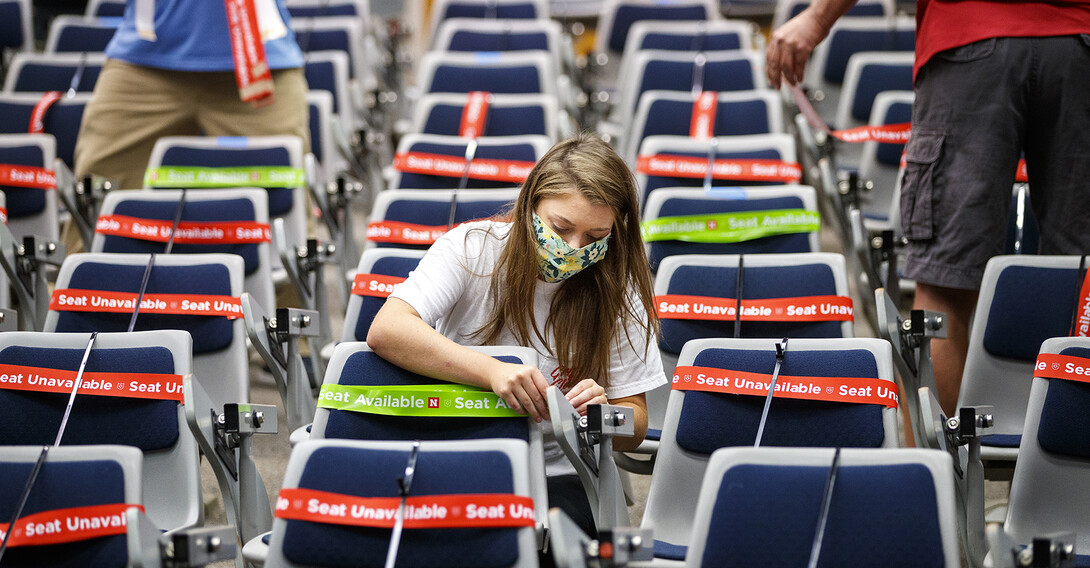
After months of planning and preparation, the University of Nebraska–Lincoln has launched a weeklong effort to prepare more than 480 classrooms for students’ return to campus.
Jack Dohrman, university space manager, is leading a team of 10 workers on assignment from the Office of the Executive Vice Chancellor and Facilities Maintenance and Operations to mark each of nearly 9,000 classroom seats to ensure social distancing during class.
The system is simple: Green vinyl clings indicates seats where students can sit; red vinyl bands and/or zip-ties that keep seats from folding down are to be avoided. Most of the indicators should be completed by Aug. 10.
Nebraska’s fall 2020 semester — which will feature in-person, on-campus instruction after COVID-19 shifted all instruction to remote access in March — launches Aug. 17. During the first week, classes will be taught remotely, with in-person instruction launching Aug. 24.
Meanwhile, a team of five from Academic Technology is making sure each classroom is fully Zoom enabled, with computer, camera and microphones. About 300 cameras are expected to arrive on campus in coming days for mounting and installation, according to Keith Derickson, academic technologies support manager.
“The goal is to have all technology installed by the start of classes,” said Heath Tuttle, chief information officer. “Many classrooms already had at least some of the equipment available, so each room has a unique set of circumstances.”
To further assist with social distancing, classrooms will be marked with designated entrances and exits, way-finding arrows, signs with posted capacity and photos showing proper set-up. Facilities Maintenance and Operations is delivering truckloads of safety supplies — disinfectants, paper towels, wipes and hand sanitizer to buildings on both East and City Campus during the next 10 days.
“All of these signs you see around you are reminders of safe practices during the COVID-19 pandemic,” Dohrman said during set up of Auditorium A and Auditorium B in Hawks Hall on Aug. 5.
Requiring students and faculty to maintain six feet from one another comes at a cost to capacity. The 385-seat Auditorium A, the College of Business’s largest classroom, is reduced to 77 seats; while the 150-seat Auditorium B will offer 52 available seats.
On average, classroom capacity has been reduced by 67%, Dohrman said. Some of the bigger auditoriums will be reduced by 80% while smaller classrooms are reduced by 60%. Dohrman’s team found that auditoriums tend to have a bigger reduction because curved rows and closely spaced seats make it harder to achieve social distancing guidance.
To compensate for the smaller capacity rooms, instructors will arrange for part of the class to attend in person and part of the class to attend remotely. Instructors have been encouraged to reach out to students as soon as formats for courses are determined.
Technology-equipped when it opened in 2017, Hawks Hall already had every room set up for Zoom, according to Associate Dean Rik Barrera and Building Operations Manager Amanda Colborn. But some rooms needed microphone boxes so that students attending via Zoom could hear their classmates. Every room now is equipped with a lapel microphone for the instructors. And, the university didn’t forget the batteries as handheld and lapel mics can be recharged and teaching stations are equipped with back-up power sources to allow instruction to continue even if the power goes out.
The preparation effort involves numerous other small details — such as equipping each room with door stops, so students to enter and leave without touching handles — all intended to further instruction flexibility while also layering in protections against the spread of COVID-19.
“This is a big, huge campus,” Dohrman said. “The coordination of the whole effort is the biggest challenge.”







